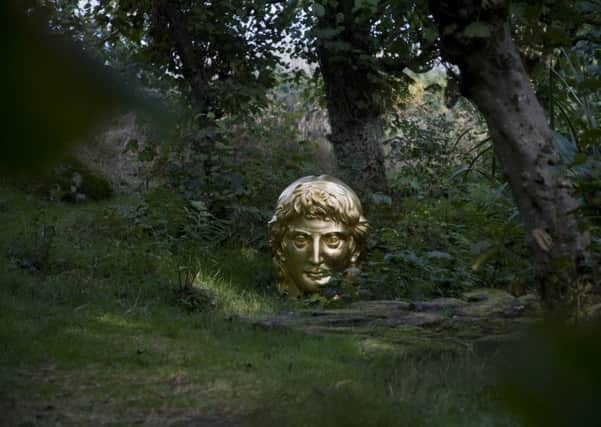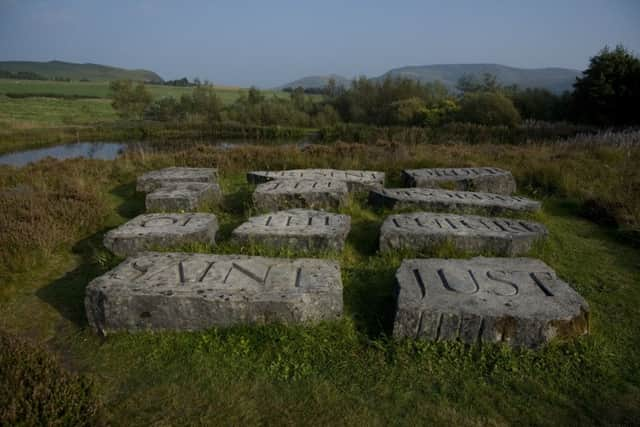Little Sparta: The making of a masterpiece


THE origins of Little Sparta go back to the days when Ian Hamilton Finlay and Sue Macdonald Lockhart first met and grew to know each other in Edinburgh in 1964. They lived together first in an old farmhouse near Ardgay in Easter Ross, where their son, Eck, was born. The house was set in a fairly large garden where their first forays into gardening took place, including the creation of a little pond, hand dug and just big enough for one person to float there in the newly made, little painted boat. With the help of furniture maker Dick Sheeler, Finlay made large installations for the garden – a concrete poem, “Happy Apple”, made of painted cork letters stuck on the white harled walls of the house; in the garden, a yellow-painted wood structure with V-shaped arms sticking up like windmill sails, or, in Finlay’s brilliant imagination, like hares’ ears. The inscription below read: The Horizon of Holland Is All Ears. In memory of earlier times spent living in Orkney, large painted wooden fish were strung up as if to dry between the arms of an old rusting agricultural machine.
The next move was to a tiny cottage in Coaltown of Callange, near Ceres in Fife, and it was there that Finlay first made glass panels with visual concrete poems sandblasted on to them. The next (and last) move was in 1966, to Stonypath, an old farmhouse given to them with its land by Sue’s parents, Simon and Catriona Macdonald Lockhart, and it was here that their daughter, Ailie, was born in1967. Set in the Pentland Hills near the tiny village of Dunsyre, it was a rough, wild and isolated spot, but the hillside and the remains of the cottage garden offered scope to incorporate works of art made out of the great library of creative thought and imagery stored in Finlay’s heart and head, and, as he hoped, the garden did indeed become a showcase for his work.
Advertisement
Hide AdFor the first few years, the couple did everything through their own hard labour, Sue combining childcare with digging, planting, cutting, weeding and pruning. Paving stones were moved from the steading to provide paths and solid bases for artworks; boulders, somehow, were levered out of the ground and heaved from one place to another. An old vegetable patch in the Front Garden was cleared, but its raspberries and its allée of currant bushes, which might be replaced by carefully pleached trees in a more traditional Grand Garden, are still there; concrete was mixed and cast, brick paths laid, wild grass and scrub cut, trees planted, wild flowers and ferns transplanted.


With Sue’s careful reading of horticultural books and manuals, alongside her imaginative skill in choosing plants, new varieties were gradually introduced. The midden on the kitchen side of the house was cleared and dug out by hand to make way for the first of a series of ponds. For a time, there was a wooden notice planted at its edge, beside a flotilla of tiny painted boats: Please Do Not Feed The Boats. A donkey was acquired and named Serpolette (wild thyme) after the name of the little steam yacht in Somerville and Ross’s novel, The Real Charlotte. A wooden weathervane with a sea-fishing theme was erected on the hillside. One after another, enormous hollows were dug out from the hillside to make a lochan and several more ponds, all fed by a moorland spring and a stream. The only work done to make the cottage more spacious and comfortable was the addition of a glazed porch, furnished with a shelf for geranium plants, wicker seats, a little table and eventually a bust of Jean-Jacques Rousseau.
Much of the area around the house was cultivated at this time. It is interesting to realise that there were far fewer gardening books available back then. In addition to Plants for Ground-Cover by Graham Stewart Thomas, which is one of the most helpful gardening books ever written, I also used Foliage Plants and The Well Tempered Garden, both by Christopher Lloyd; and I was given by Ian’s mother a signed copy of William Robinson’s The English Flower Garden. There were others, of course, but these were my own personal chief influences. We had a tiny paperback on garden planning that was very influential for Ian; I can’t remember the author. We also had The English Garden by Edward Hyams and later The English Cottage Garden by – I think – the same author. These were much used as reference points – remember, Ian couldn’t travel at all. At one time we also had a subscription to Country Life. In1980 I got ME. This seriously affected me. I couldn’t walk across a room unaided and for much of the first two years I was in bed. I couldn’t stir the soup far less wield a spade. Therefore all the ideas in my head for the garden and how it was to be continued came to a terrible halt. When I regained some capability (I still have the illness), it was felt that it was more important that I travel for Ian (since he was grounded by agoraphobia) to put up the exhibitions and installations that he was now being invited to in Europe and America, as well as in Britain. Throughout the 1980s there was this opportunity to show his work and earn some money.
This was what the garden had been made for – to demonstrate his work. And this is what I did. So, the garden’s real development was at least partially interrupted. Works continued to be made and when I could I continued to plant, weed and prune. Eck and Ailie were gallant helpers. Ground cover became very important. Meantime the trees and shelter belts grew and some became far too big and dense. Sometimes it is difficult to see what is happening in front of your eyes, especially when it happens slowly. Ian was always looking towards the next project, the next show, the next installation. As well as the garden, Ian and Sue began the work of transforming the old farm outbuildings into a temple precinct at the heart of an artist’s garden, and, from an early stage, the practice of enrolling sculptors, artists and others with special skills to carry out Finlay’s designs. After lengthy repair and redecoration, the largest building was dedicated to Hyperborean Apollo, god of music, prophecy, archery and, perhaps importantly here, controller of mice. Inside, artworks were on display and anyone could visit on application.
Sue successfully applied to Strathclyde Regional Council for relief on the rateable value of what the Region called the Stonypath Gallery, but in 1978 the Region unilaterally withdrew relief on the intriguingly various grounds that relief was only available to organisations, not individuals, that it did not qualify for relief as a religious building, that Finlay might sell something in it, that public access to it was restricted by the need to phone or write for an appointment, and that he did not have an Arts Council grant. In 1979, after fruitless correspondence with the Region, Finlay wrote to inform them that the building had now been redefined as a Canova-type temple, and that he would welcome any official of the Region to come and discuss the situation within temple hours.
In 1980, Finlay named the garden Little Sparta to distinguish it from Edinburgh – Athens of the North – and to honour the ascetic, uncompromising and battle-ready city state of ancient Sparta. Eventually the Region decided to act, and a sheriff officer came to make an inventory of works in the temple that were to be taken away. Partway through this task, he abandoned it, bought a work and wrote a cheque for the money due to Strathclyde. However, the dispute rumbled on and Finlay withdrew from a planned exhibition of his work.
Advertisement
Hide AdEarly in 1983 a sheriff officer was authorised to seize works from the temple. When he arrived at the garden, he was confronted by a band of Finlay’s supporters, named, in a spirit of mingled humour and defiance, the Saint-Just Vigilantes. Headquarters were set up in the dilapidated barn. Sue, on horseback, took a leading role in the confrontation, and in the first battle of Little Sparta, on 4 February 1983, they defeated the sheriff officer’s attempt to seize works from the temple. Two weeks later, in the Budget Day Raid, when the nation’s attention was deflected to Westminster, Strathclyde’s officer returned and succeeded in taking away several works, some belonging to art collectors and public institutes. Few of these works have ever been returned, but Strathclyde Region no longer exists. Around this time Finlay published a series of ‘Detached Sentences on Revolution’ from the Committee of Public Safety, Little Sparta. One declares:
FREEDOM OF SPEECH IS NOT FREEDOM TO SPEAK IT IS THE FREEDOM TO DISCUSS
Advertisement
Hide AdIn addition to his work on the garden, Finlay continued to publish posters and cards. One tiny card, Summer Poem Little Sparta, celebrates the welcome sight of the red post van coming up the track, as the wild roses bloom:
wild
post
rose
van
Another sagely announces: Mower is Less.
His passion for football prompted another: A World Cup without Scotland is like a pastoral without sheep.
The scope of Finlay’s work as a designer of installations for both indoor and outdoor settings expanded internationally, and Sue collaborated and supervised on the siting of thirty-three of the seventy-seven permanent installations in Europe. Following her diagnosis of ME, her energy was greatly reduced and in 1989 she left Stonypath, her relationship with Finlay having deteriorated by then. Ralph Irving was installed as gardener, and Finlay embarked on one of his last major developments, the creation of the English Parkland.
During a long relationship with Pia Maria Simig, who worked closely with him, supervising installations and exhibitions of his work throughout the world, he became more and more renowned internationally. One of the most intensive projects they undertook was the creation in 2003 of Fleur de l’Air, a private garden in Provence, which includes many works which have echoes of those at Little Sparta, but with imagery appropriate to the rugged terrain, and the different climate and culture. Simig directed operations on site, corresponding regularly with Finlay, and frequently returning to Little Sparta for discussion and instructions. Irving, too, made several trips out to assist in the creation of the garden.
Shortly before his death, Finlay decided to convert the dilapidated barn at Little Sparta into a creative ruin, in which he created a Hortus Conclusus, or medieval garden. More recently, his house, at the heart of the garden, has been adapted to create a postgraduate study centre, thanks to a generous grant from the University of Edinburgh and the College of Art. Poet, printmaker, garden designer, wit, campaigner and moralist, Finlay is unforgettable. He died in 2006. His garden at Little Sparta, a fragile but enthralling installation in a beautiful but demanding setting, remains an unstinting source of delight.
• Little Sparta: A Guide to the Garden of Ian Hamilton Finlay is published by Birlinn, £14.99